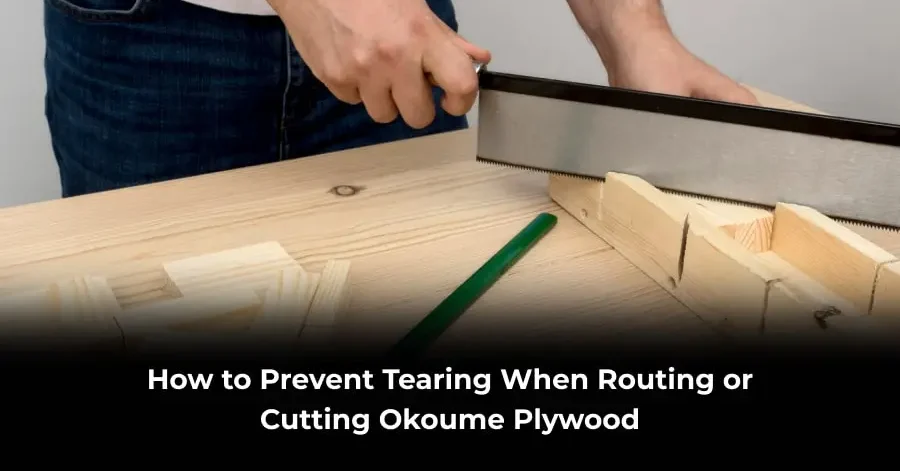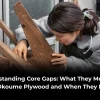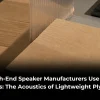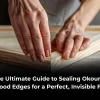There’s a moment of truth in every woodworker’s project when you make that critical cut or run the router along an edge. With a material as beautiful and versatile as Okoume marine plywood, the goal is always a flawless, glassy-smooth finish. But then it happens: a dreaded splinter of wood tears away, leaving a ragged, fuzzy edge that can feel like a setback. If you’ve ever felt the frustration of tear-out, you’re not alone.
Okoume plywood, prized for its light weight, smooth surface, and excellent bendability, is a top choice for boat building, fine furniture, and cabinetry. However, its multi-layered, cross-grain construction and relatively soft face veneers make it particularly susceptible to tearing. The good news? Preventing this is entirely within your control. It’s not about luck; it’s about technique and the right woodworking supplies.
This comprehensive guide is your ally in the workshop. We’ll walk through the essential strategies, from blade selection to hands-on techniques, that will ensure your work with this premium okoume marine plywood remains clean, professional, and tear-free.
Understanding the “Why”: Why Does Okoume Plywood Tear Out?
Before we fix the problem, let’s understand it. Tear-out occurs when the cutting tool’s teeth don’t cleanly slice through the wood fibers but instead rip them out ahead of or behind the cut. This is especially common in plywood because:
- Alternating Grain Direction: Each layer (ply) has its grain running perpendicular to the one below it. A blade cutting cleanly with the grain on one layer might be cutting against the grain on the next, inviting tear-out on the exit side.
- Soft Face Veneers: Okoume is not a hardwood. Its lovely, often figured face veneers are soft and can be fragile, making them prone to chipping and splintering if not supported properly during cutting.
The key principle to remember is: Support the fibers and use a sharp, fine-cutting tool. Let’s break down how to apply this principle to your tools and techniques.
Part 1: The Foundation – Your Tools and Blades
Your first line of defense against tear-out is the hardware you use. Investing in the right blade is non-negotiable when working with high-quality okoume plywood.
- The Circular Saw or Table Saw Blade:
Forget the generic blade that came with your saw. You need a blade designed for fine, splinter-free cuts.
- Tooth Count is King: Use a blade with a high tooth count. A 80-tooth finish blade or a 100+ tooth panel-processing blade is ideal. More teeth mean a finer, cleaner cut because each tooth removes a smaller chip of material.
- Tooth Geometry Matters: Look for blades labeled “Triple-Chip Grind (TCG)” or “Alternate Top Bevel (ATB)” with a high angle (around 40°). These designs slice through the wood fibers cleanly rather than chopping at them.
- Sharpness is Non-Negotiable: A dull blade will tear and crush fibers rather than cut them. If your blade is leaving burn marks or rough cuts, it’s time for a sharpening or replacement. A well-stocked woodworking supplies store will carry a range of high-quality, fine-finish blades perfect for the job.
- The Jigsaw Blade:
For curved cuts in okoume marine plywood, a jigsaw is indispensable, but it’s a notorious culprit for tear-out on the top surface.
- Choose a Fine-Tooth Blade: Select a blade with a high TPI (teeth per inch)—20 TPI or higher is a good starting point.
- Downward-Cut Blades are Your Best Friend: This is a pro-tier tip. Specialized “reverse-tooth” or “down-cut” blades cut on the downward stroke. This forces the fibers down against the core of the plywood, ensuring the clean face is on top. The underside will be rougher, so always cut with the good face up.
- The Router Bit:
Routing the edges of okoume plywood can produce the most beautiful profiles—or the most heartbreaking tear-out.
- Spiral Bits Over Straight Bits: A down-cut spiral router bit is the ultimate weapon. Like the down-cut jigsaw blade, it shears the wood fibers downward, leaving a perfectly clean top edge. Up-cut spiral bits are great for clearing chips but will tear the top surface; save them for mortising.
- Sharpness and Speed: A sharp router bit is crucial. Also, experiment with feed rate and speed. Sometimes, a slower feed rate combined with a higher router speed can yield a cleaner cut by allowing the bit to take smaller, cleaner bites.
Part 2: The Technique – Your Hands-On Strategy
The finest blade in the world won’t help if your technique is working against you. These hands-on methods are what separate a hobbyist from a master craftsman.
- The Zero-Clearance Throat Plate (Table Saw):
The gaping throat plate on your table saw is a primary cause of tear-out. As the blade exits the bottom of the plywood, the unsupported fibers easily tear into that gap. A zero-clearance throat plate is a custom insert that fits snugly around your blade, providing critical support right up to the blade’s edge. You can buy one or make your own from plywood or phenolic. - Sacrificial Backing Boards:
This is the most versatile and effective technique for virtually all cutting tools.
- For Saw Cuts: Place a sheet of rigid foam insulation or a scrap piece of MDF underneath your okoume plywood when using a circular saw. For a table saw, use a sacrificial piece of wood behind the workpiece to support the fibers as the blade exits.
- For Routing: Clamp a scrap piece of wood to the exit side of your router’s path. This prevents “blow-out” as the bit leaves the edge of your precious okoume marine plywood project piece.
- Score Your Cut Line:
A simple yet profoundly effective trick. Use a sharp utility knife and a straightedge to deeply score along your intended cut line. By severing the top veneer fibers beforehand, you create a predefined breaking point, preventing the tear from propagating beyond your score line. This is exceptionally effective for cross-grain cuts on a table saw. - Tape It Up:
Low-tack painter’s tape (blue tape) is a woodworker’s best friend. Apply a strip of tape directly over your cut line on both the top and bottom of the sheet. The tape holds the fibers together, minimizing chipping. Once the cut is complete, simply peel the tape away to reveal a clean edge. This method works wonders for both sawing and routing operations on okoume plywood. - Feed Rate and Support:
Pushing the material too fast (or too slow) can cause tear-out. Feed the material at a consistent, steady rate that allows the blade to cut without bogging down or burning. Always ensure the workpiece is fully supported on both the infeed and outfeed sides of your saw to prevent it from sagging and pinching the blade.
AEW Wood: Your Partner in Premium Woodworking
Once you’ve mastered the techniques for handling okoume marine plywood, the next critical step is sourcing the best possible material. The quality of the plywood itself—the glue, the core, and the integrity of the veneers—plays a huge role in how it machines. This is where AEW Wood comes in.
AEW Wood has built a reputation as a trusted supplier of exceptional okoume plywood and other specialty marine and hardwood plywoods. They understand that for serious woodworkers, boat builders, and craftsmen, consistency and quality are paramount. When you source your okoume marine plywood from AEW Wood, you can be confident you’re getting a product with:
- High-Grade Veneers: Consistently smooth, thin, and free of defects that can lead to unexpected tear-out.
- Superior Bonding: Waterproof marine-grade adhesive that holds the plies firmly together during aggressive machining.
- Expert Knowledge: Their team can provide advice on the best type of okoume plywood for your specific project, ensuring you start on the right foot.
Choosing a supplier like AEW Wood isn’t just about buying materials; it’s about investing in the success of your project from the very beginning.
Conclusion
Working with okoume marine plywood should be a joyful and rewarding experience. Its beautiful appearance and workability are what draw us to it in the first place. By understanding the nature of the material and marrying that knowledge with sharp, appropriate tools and mindful technique, you can eliminate the frustration of tear-out for good.
Remember the core tenets: support the fibers with zero-clearance inserts and backing boards, slice them cleanly with high-tooth-count blades and sharp router bits, and pre-empt them with scoring and tape. And never underestimate the importance of starting with a superior product from a reputable source. Whether you’re building a sea-worthy vessel or a piece of heirloom furniture, these practices will ensure that your work with okoume plywood is nothing short of impeccable. Now, head to your woodworking supplies store with confidence, equip yourself properly, and make those clean, tear-free cuts you’ve been striving for.
Frequently Asked Questions (FAQs)
Q1: I only have a standard 40-tooth blade. Can I still get a clean cut on my okoume plywood?
A: You can improve it significantly by using the scoring method or applying painter’s tape over your cut line. However, for consistently perfect results, especially on visible edges, upgrading to a high-tooth-count blade is highly recommended. It’s an investment that will pay off across all your fine woodworking projects.
Q2: Which side of the okoume marine plywood should face up when cutting on a table saw?
A: The good side (the face you want to remain clean) should face up. The table saw blade rotates upwards into the workpiece, so any tear-out from the blade will primarily occur on the top surface. The zero-clearance throat plate is designed to prevent this. The bottom side is typically cleaner as the blade teeth exit into the wood.
Q3: My router is still tearing the wood on the exit side, even with a sharp bit. What am I doing wrong?
A: This is a classic sign of “blow-out.” The solution is almost always the sacrificial backing board. Ensure you have a scrap piece of wood firmly clamped to the exit edge of your workpiece. This supports the very last fibers as the router bit exits, preventing them from breaking away.
Q4: Is a tracksaw a good option for cutting okoume plywood?
A: Absolutely. A tracksaw is one of the best tools for the job. It combines a high-quality blade with a built-in zero-clearance system (the track) and often uses a splinter guard strip, all of which work together to deliver virtually tear-free cuts right out of the box.
Q5: Can I sand out tear-out on okoume plywood?
A: Minor fuzziness can be sanded out, but deep tear-out is very difficult to repair without being visible. The face veneers on okoume plywood are very thin. Sanding aggressively to remove a deep chip can easily sand through the veneer entirely, creating an even bigger problem. Prevention is always better than the cure.






